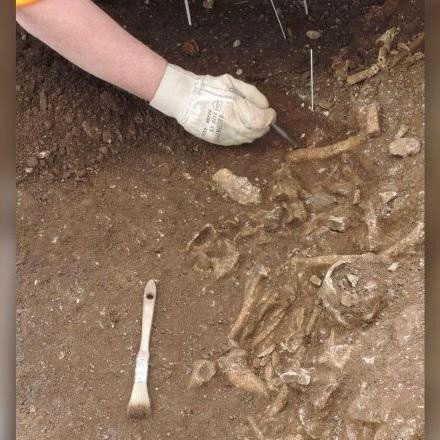The mysterious 6,500-year-old grave of a woman, along with several arrowheads, discovered in northern France may reveal insights about the treatment of women during the Neolithic period.
Researchers have examined massive graves stretching hundreds of meters within decayed wooden planks. Among the 19 graves at the Neolithic cemetery in Fleury-sur-Orne, Normandy, France, the team analyzed the DNA of 14 individuals; however, only one was identified as a woman.

The only female grave found in the grand cemetery in Normandy, France, from the Neolithic period.
The Mystery of the Woman’s Grave
The woman was buried with arrowheads “symbolizing men” in her grave.
The lead author of the study, Maïté Rivollat, an archaeologist and geneticist at the University of Bordeaux, France, stated: “We believe that the artifacts belonging to men transcended biological gender identity. This implies that she embodied masculinity in death to be buried in this cemetery.”
Archaeologists suggest that the graves in Fleury-sur-Orne belong to the Cerny culture of the Neolithic period. Other Cerny cemeteries have been found hundreds of kilometers away in the southeastern region of Paris, but Fleury-sur-Orne is the largest cemetery discovered in Normandy.
Despite being part of the Cerny culture, the cemetery at Fleury-sur-Orne was predominantly for men, specifically hunters, making the discovery of a woman’s grave here quite surprising.
The Neolithic cemetery in Fleury-sur-Orne near Caen was first identified through aerial photographs taken in the 1960s, and the French National Institute for Preventive Archaeological Research (Inrap) has led a rescue excavation there since 2014.
Signs of a Patrilineal Community
Clues and DNA analysis suggest that those buried in Fleury-sur-Orne came from a patrilineal community—where social power is inherited through the male line, while daughters leave to live with their husbands’ families.
Previous studies of the Cerny cemetery in the Paris basin distinguished “powerful individuals” by burying them with arrowheads, weapons, and possibly bows—indicating their status as “hunters.”
It is unclear whether the woman buried in the Cerny cemetery in Fleury-sur-Orne was officially recognized by the community as a “hunter,” but she was interred with four arrowheads, a type of artifact typically associated with men in Cerny culture.


















































